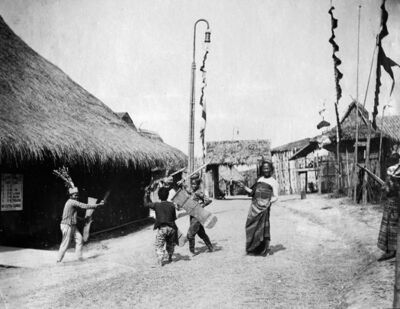Moro Village: Difference between revisions
No edit summary |
No edit summary |
||
| Line 9: | Line 9: | ||
| location = [[Philippine Exhibit]] | | location = [[Philippine Exhibit]] | ||
| no_buildings = 1 | | no_buildings = 1 | ||
| construction_cost= $ | | construction_cost= $8,769 (${{Format price|{{Inflation|US|8,769.80|1904}}}} in {{Inflation/year|US}}) | ||
| furnishing_cost = | | furnishing_cost = | ||
| profit = | | profit = $67,639 (${{Format price|{{Inflation|US|67,639.04|1904}}}} in {{Inflation/year|US}}) | ||
| owner = | | owner = | ||
| architect = | | architect = | ||
Latest revision as of 02:03, 7 March 2024
 | |
| Location | Philippine Exhibit |
|---|---|
| No. of Buildings | 1 |
| Construction | |
| Construction Cost | $8,769 ($264,491 in 2021) |
| Proft | $67,639 ($2.04 million in 2021) |
A village of two tribes of Moros of Mindanao was built on the shores of Lake Arrowhead in the Philippine Exhibit
Description[edit | edit source]
Split into two tribes the Samal Moros were coast dwellers, pirates and seafaring men; and the Lanao people occupied the interior of Mindanao. Unlike the Lanao, the Samal Moros had been friendly since American occupation, they lived on stilted huts over the water. Ruled over by Rajah Muda Mandi, an intelligent and wealthy man, who had the power of life and death over more than 5,000 subjects.
Since the hatred between between the two tribes was so intense, special guards were on duty in the villages to keep them separate.
Signs were posted not to photograph the Lanao as it was taboo with their Mohammedan faith. The Lanao had no problem showcasing their hatred for Christians and tended to stay in their huts and would not usually perform for visitors.
